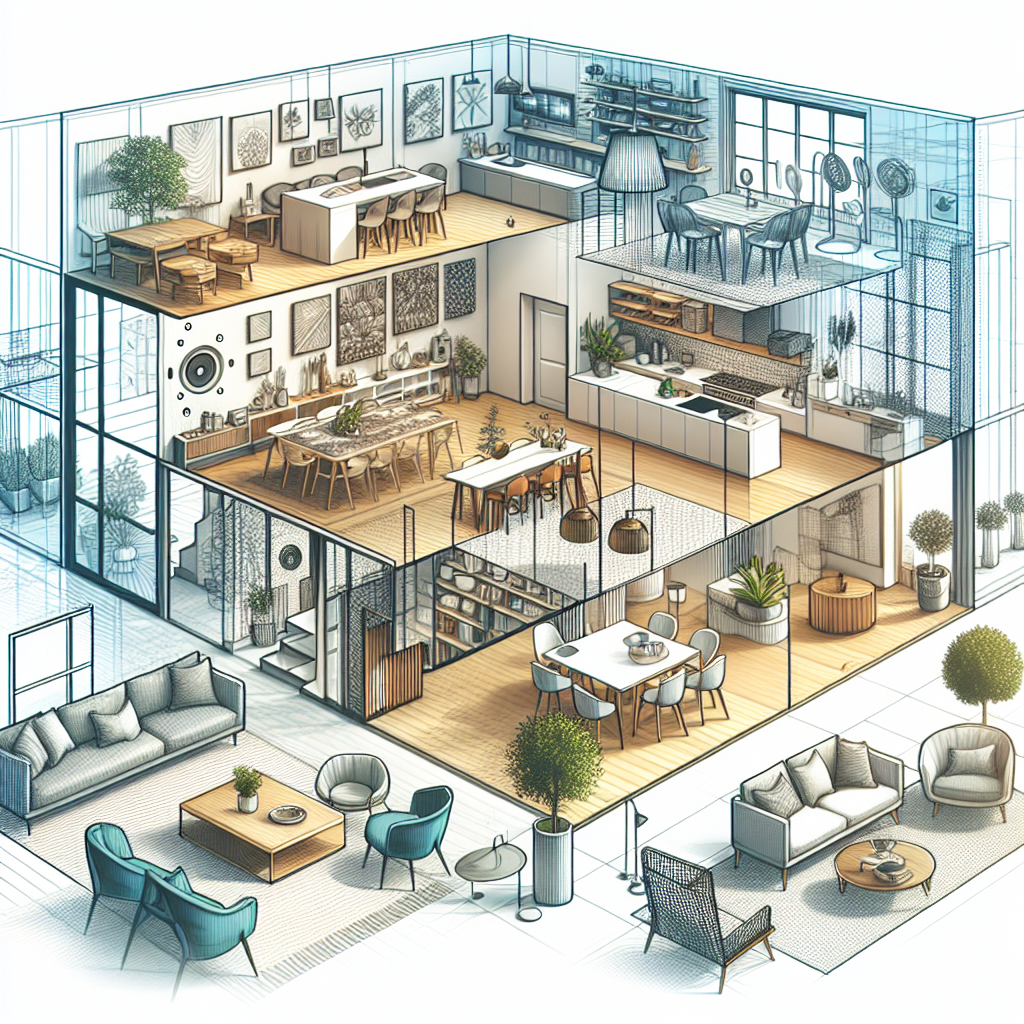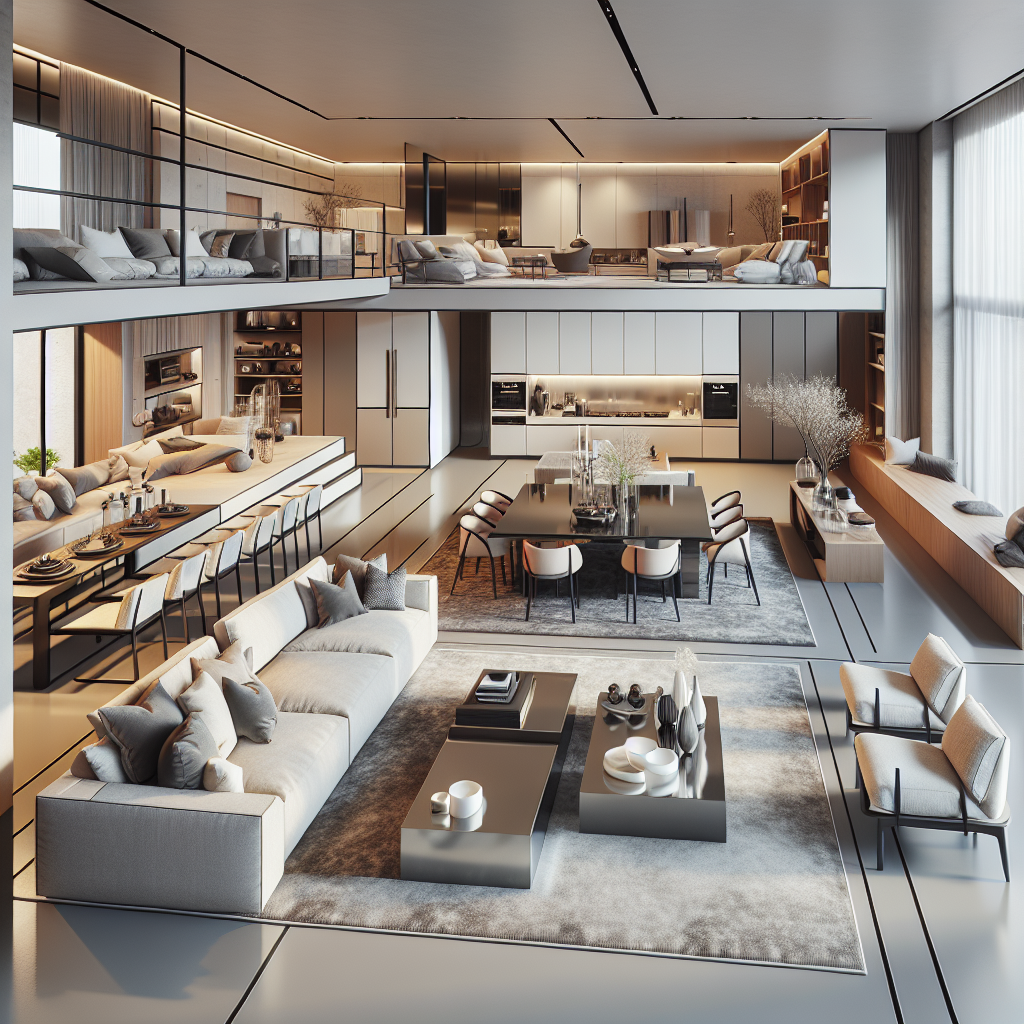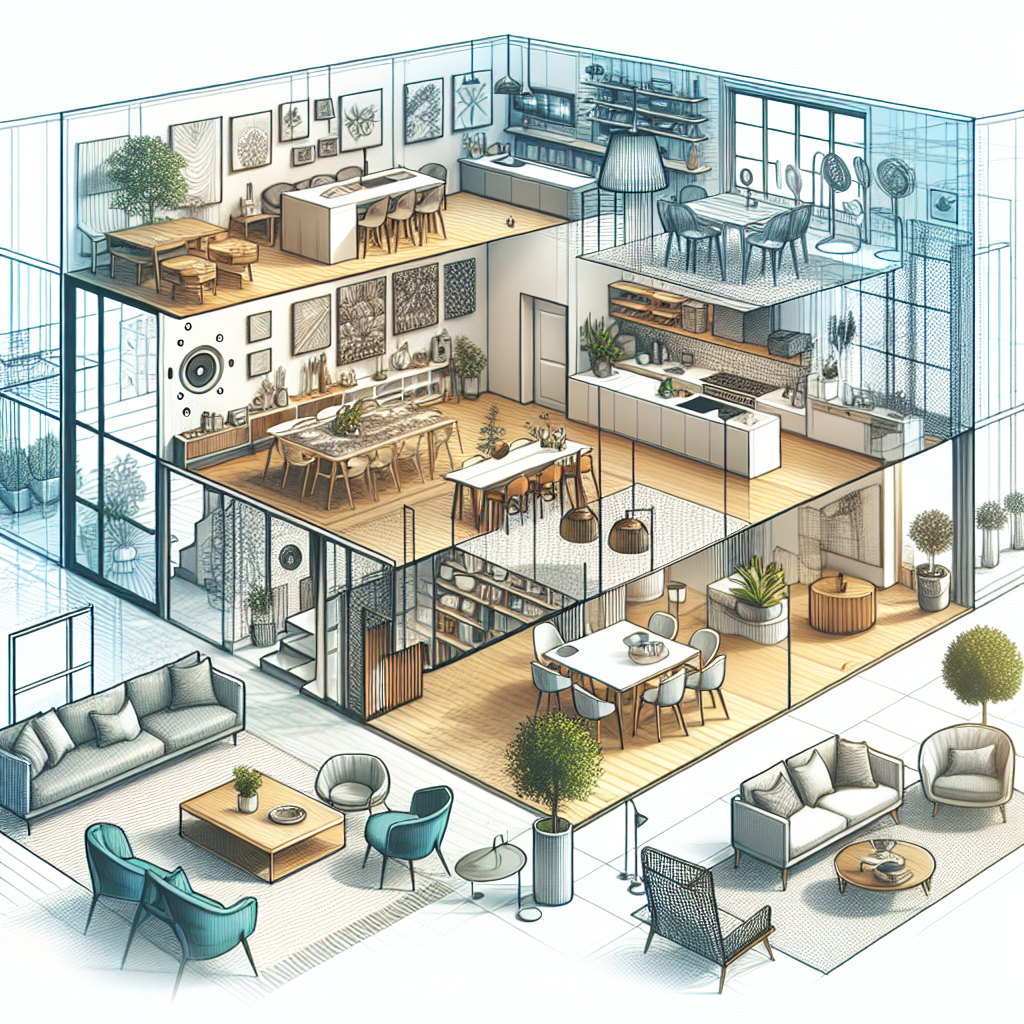
So, you’ve decided to embrace the open-concept living trend, but now you’re wondering how to make the most of this popular home design style. Well, look no further! In this article, we’ll explore some valuable tips to help you navigate the challenges and maximize the benefits of open-concept living. Whether you’re seeking inspiration for your residential interior, craving house design ideas, or simply looking to create a harmonious and functional space, we’ve got you covered. So let’s roll up our sleeves and dive into the world of open-concept living!
Space Planning

Consider the flow of traffic
When designing an open-concept space, it’s crucial to consider the flow of traffic. You want to ensure that people can move easily and comfortably throughout the area. Think about how you and your guests will navigate from one zone to another without feeling cramped or obstructed. Pay attention to the placement of furniture and create clear pathways to guide the traffic.
Create distinct zones
Open-concept living often involves combining multiple functional spaces in one large area, such as a living room, dining room, and kitchen. To avoid the space feeling overwhelming or chaotic, it’s important to create distinct zones within the room. You can achieve this by using furniture placement, area rugs, or even changing floor materials. By clearly defining different areas, you create a sense of purpose and organization in the space.
Utilize furniture placement to define spaces
Furniture placement plays a crucial role in open-concept living. It can help define different areas and visually separate them, even without physical barriers. For example, a sofa or a bookshelf can act as a divider between the living room and dining area. Be mindful of the size, scale, and arrangement of furniture to ensure that it enhances the overall flow and functionality of the space.
Leave enough room for movement
While it’s important to maximize seating and storage options in an open-concept space, it’s equally important to leave enough room for movement. Make sure there is ample space for people to walk around and comfortably navigate between furniture and different zones. Avoid overcrowding the area with too much furniture or oversized pieces that impede movement. After all, a well-designed open-concept space should feel spacious and inviting.
Color and Lighting
Choose a consistent color palette
In open-concept living, maintaining a consistent color palette is essential for visual cohesion. Selecting a cohesive collection of colors will tie the different areas together and create a harmonious flow throughout the space. Consider the overall style and atmosphere you want to achieve and choose colors that reflect that aesthetic. Whether you opt for soothing neutrals or bold pops of color, ensure that the palette is consistent and complements the overall design.
Use lighting to create ambiance
Lighting is a crucial aspect of any interior design, and open-concept spaces are no exception. Use a combination of ambient, task, and accent lighting to create various moods and highlight different areas within the space. Pendant lights or chandeliers can define the dining area, while floor or table lamps can create a cozy atmosphere in the living area. Dimmer switches are also a great addition, allowing you to adjust the lighting level to suit different occasions.
Consider natural light
Open-concept living often showcases large windows and plenty of natural light. Take advantage of this feature by strategically arranging furniture to make the most of the views and natural light. Avoid blocking windows with bulky furniture and instead position seating or dining areas to optimize natural light. harnessing the beauty of natural light not only enhances the overall ambiance but also creates a sense of openness and connection with the outdoors.
Use mirrors to maximize light
Mirrors are a fantastic tool to maximize the light and create a sense of spaciousness in open-concept living. Place mirrors strategically opposite windows or in areas where they can reflect light throughout the space. This simple trick can amplify natural light, making the room feel brighter and more expansive. Additionally, mirrors can also serve as decorative elements, adding visual interest to the walls and reflecting unique views or artwork.
Furniture Selection
Opt for multifunctional furniture
In open-concept living, every square inch of space counts. To maximize functionality and versatility, opt for multifunctional furniture pieces. Look for sofas with built-in storage, coffee tables with hidden compartments, or dining tables that can extend to accommodate more guests. By incorporating furniture with multiple purposes, you not only save space but also add practicality to your living area.
Consider the scale of furniture
When selecting furniture for your open-concept space, pay close attention to scale. Large, bulky furniture can overpower the room, making it feel cramped and unbalanced. Conversely, choosing furniture that is too small can make the space appear empty or poorly furnished. Find the right balance by considering the size of the room and the proportions of your furniture pieces. Ideally, your furniture should be proportional to the space while still providing ample seating and functionality.

Choose furniture that complements the overall style
The furniture you choose should complement the overall style and aesthetic of your open-concept space. Whether you prefer a modern, minimalist look or a cozy, traditional feel, select furniture that aligns with your desired design scheme. Consider the materials, finishes, and colors of the furniture to ensure they harmonize with the surrounding elements. Cohesiveness in furniture selection will tie the entire space together, creating a visually pleasing and well-designed environment.
Create cozy seating areas
With an open-concept living area, it’s important to create various cozy seating areas to accommodate different activities and gatherings. Intimate seating arrangements, such as a pair of armchairs and a side table, can create a cozy reading nook. A sectional sofa or a cluster of chairs can define a conversation area for entertaining guests. By strategically placing seating throughout the space, you encourage relaxation and conversation while ensuring optimal use of the available area.
Storage Solutions
Utilize built-in shelves or cabinets
When it comes to storage in open-concept living, built-in shelves or cabinets are invaluable. These can be customized to fit the specific needs of your space and provide ample room for storing books, displaying decor, or concealing clutter. Built-ins also create architectural interest and can serve as focal points in the room. Consider incorporating them into areas such as dining nooks or entertainment centers to maximize functionality and style.
Incorporate hidden storage options
To maintain a clean and organized open-concept space, incorporating hidden storage options is essential. Look for furniture pieces with hidden compartments, such as ottomans with hidden storage or TV stands with drawers. These discreet storage solutions allow you to keep everyday items within easy reach while minimizing visual clutter. Additionally, think creatively about underutilized areas, such as under the stairs or low-profile beds, which can be transformed into clever storage spaces.
Optimize vertical space
In open-concept living where floor space is often limited, optimizing vertical space is key. Consider installing floor-to-ceiling shelving or wall-mounted storage units to make the most of unused wall space. Vertical storage not only maximizes storage capacity but also draws the eye upward, making the room feel taller and more spacious. Utilize vertical space for items like books, decorative accents, or even hanging plants to add visual interest and functionality to your space.

Use decorative storage baskets or bins
To keep your open-concept living area organized and clutter-free, incorporate decorative storage baskets or bins. These functional and aesthetically pleasing containers can be used to stow away items such as blankets, toys, or magazines. Choose baskets or bins that complement your overall style and place them strategically throughout the space. By combining practicality with visual appeal, you can keep your belongings within reach while maintaining a tidy and visually pleasing environment.
Visual Continuity
Maintain a consistent flooring type
One of the key elements in achieving visual continuity in open-concept living is maintaining a consistent flooring type throughout the space. Whether it’s hardwood, tile, or carpet, using the same flooring material creates a sense of flow and unity. Consistency in flooring also helps visually connect different zones within the open-concept area, making it feel cohesive and well-designed. The seamless transition between areas creates a harmonious atmosphere that is pleasing to the eye.
Match finishes and materials
In addition to flooring, matching finishes and materials throughout the open-concept space is crucial for visual continuity. Consistency in finishes, such as cabinetry hardware, lighting fixtures, and faucets, creates a cohesive look and ties the different areas together. Consider using the same or similar finishes on elements like door handles, light switches, and even outlet covers. This attention to detail ensures a polished and harmonious aesthetic throughout the space.
Consider sightlines throughout the space
Open-concept living often means that multiple areas are visible from any given point within the room. When planning the layout and design, consider the sightlines and how they interact. Ensure that there are no obstructions that hinder the flow of visuals. Avoid placing tall furniture or objects that block the view between different zones. By maintaining clear sightlines, you create a sense of openness and connection, making the space feel cohesive and inviting.
Ensure cohesive color coordination
Color coordination is essential for visual continuity in open-concept living. Choose a color scheme that complements the overall style and carries through the different areas of the space. Consider using accent colors or patterns that can be repeated in various elements, such as throw pillows, artwork, or curtains. By ensuring cohesive color coordination, you create a seamless and aesthetically pleasing environment that feels unified and well-designed.
Privacy and Acoustics

Use room dividers or screens
While open-concept living promotes a sense of openness and connectivity, there are times when you may desire privacy or separation between different zones. Utilize room dividers or decorative screens to create visual and physical barriers when needed. These can be movable and foldable, allowing flexibility in adjusting the layout and privacy level. By incorporating room dividers or screens, you can create private spaces or shield certain areas from view without sacrificing the overall aesthetic of your open-concept living area.
Incorporate curtains or blinds
For moments when you want to block out light or create privacy, curtains or blinds are excellent additions to an open-concept space. Choose window treatments that allow for easy adjustment and provide the desired level of privacy for each area. Curtains in a heavier fabric or blinds with blackout options can help designate more private areas, such as bedrooms or home offices. By effectively managing privacy while still allowing natural light to filter in, you can strike the perfect balance in your open-concept living area.
Choose sound-absorbing materials
Open-concept living often means that noise can travel freely throughout the space. To minimize sound disturbances and create a more acoustically balanced environment, choose sound-absorbing materials. Opt for rugs with thick padding, acoustic panels on walls, or curtains made of heavy fabric to lessen echoes and absorb sound. Incorporating these materials strategically can help create a quieter and more comfortable living space within the open-concept layout.
Strategically place furniture for acoustic balance
In open-concept living, the placement of furniture can greatly affect the acoustics of the space. Arrange furniture strategically to help absorb and diffuse sound. Placing upholstered furniture or adding cushions to hard surfaces can help to minimize sound reflections. Additionally, positioning furniture away from walls or creating alcoves with bookshelves can help break up the sound waves and improve the acoustic balance of the space. By considering acoustics in your furniture arrangement, you can create a more enjoyable and harmonious living environment.
Storage Solutions
Optimize vertical space
When it comes to storage solutions, vertical space is often an untapped resource in open-concept living. Utilize the height of your walls by installing tall shelves or cabinets that reach up to the ceiling. This maximizes storage capacity while keeping the floor area free and uncluttered. Utilizing vertical space is especially valuable for storing items that are not frequently used, such as seasonal decorations or extra bedding. Don’t overlook the potential of your walls when it comes to storage in open-concept living.

Utilize built-in organizers
Built-in organizers can be a game-changer when it comes to decluttering and maintaining order in an open-concept space. Install custom organizers in closets, cabinets, and drawers to maximize storage efficiency. Built-in organizers can be customized to your specific needs, ensuring that every inch of storage space is utilized effectively. Whether it’s a shoe rack in the entryway or a custom pantry system in the kitchen, built-in organizers bring functionality and organization to your open-concept living area.
Maximize underutilized areas
In an open-concept living area, it’s important to make the most of every nook and cranny. Identify underutilized areas, such as corners and recesses, and find creative storage solutions that fit seamlessly into these spaces. Consider installing floating shelves or corner cabinets to utilize those areas effectively. You can also repurpose awkward spaces by incorporating hanging hooks or shelves for additional storage. By thinking outside the box and maximizing underutilized areas, you can optimize the storage capacity of your open-concept living space.
Consider multifunctional storage solutions
Multifunctional storage solutions are a perfect fit for open-concept living, where versatility is key. Look for furniture pieces that serve dual purposes, such as ottomans that open up to reveal storage space or coffee tables with hidden compartments. Invest in storage benches or seating with built-in storage to maximize functionality without sacrificing style. By choosing multifunctional storage solutions, you can keep your open-concept living area organized while also adding practical and stylish elements to the space.
Decorative Elements
Use rugs to define different areas
Rugs are a fantastic way to define different areas within an open-concept living space. They can anchor furniture groupings, create visual boundaries, and add warmth and coziness to the room. Choose rugs that fit the scale of the area and complement the overall design scheme. A large area rug can clearly define the living room, while a smaller rug can mark the dining area. By strategically placing rugs, you provide a visual cue for each zone and enhance the overall design of your open-concept living area.
Incorporate plants for natural freshness
Plants add a touch of nature to any space and can be especially beneficial in open-concept living. They not only provide a visually pleasing element but also purify the air and improve indoor air quality. Place potted plants strategically throughout the open-concept area to create a fresh and vibrant atmosphere. Consider different sizes and varieties to add height and texture to the space. Plants can also act as natural room dividers or screen unsightly views, enhancing the overall aesthetics of your open-concept living area.
Display artwork or photographs as focal points
Artwork or photographs can serve as focal points in an open-concept living area, drawing the eye and adding personality to the space. Choose pieces that reflect your personal taste and complement the overall design style. Position larger artworks on walls that can be seen from different areas of the room, creating a cohesive and visually engaging environment. Group smaller artworks or photographs together to create curated gallery walls that showcase your personal memories and experiences. By incorporating art and photographs, you infuse your open-concept living area with character and individuality.
Utilize decorative screens or partitions
Decorative screens or partitions are not only functional but can also serve as decorative elements in open-concept living. They provide privacy, define areas, and add visual interest to the space. Whether you choose a folding screen, a room divider made of natural materials, or a decorative partition with intricate designs, these additions can become statement pieces in your open-concept living area. Place them strategically to enhance the overall aesthetics and create a sense of separation or focus within the room.
Maintaining Visual Order
Regularly declutter and organize
One of the key strategies for maintaining visual order in open-concept living is to regularly declutter and organize your belongings. Clutter can quickly make the space feel chaotic and overwhelming. Set aside dedicated time to declutter items you no longer need and organize your belongings in designated storage spaces. By regularly going through your possessions and keeping them organized, you can create a clean and visually pleasing open-concept living area.
Create designated storage spaces
In an open-concept living environment, it’s essential to have designated storage spaces for specific items. Assign specific cabinets, shelves, or drawers for particular categories, such as books, electronics, or board games. Labeling storage areas can also help maintain order and ensure that items are easily accessible and put back in their designated places. By creating designated storage spaces, you not only keep the space organized but also make it easier to find items when you need them.
Use furniture with hidden storage compartments
Furniture with hidden storage compartments is a great way to maintain visual order while maximizing functionality. Look for coffee tables, ottomans, or benches with hidden storage options to keep smaller items tucked away and out of sight. These furniture pieces provide a stylish solution for storing items while still maintaining a clean and clutter-free open-concept living area. By incorporating furniture with hidden storage compartments, you can easily keep your belongings organized and the space visually appealing.
Implement proper cable management
With multiple electronic devices in an open-concept living area, cable management is crucial to maintain visual order. Tangled cords and exposed wires can create a messy and disorganized look. Utilize cable management solutions such as cable sleeves, adhesive clips, or cable trays to keep wires neatly organized and hidden. Consider investing in furniture or shelving with built-in cable management features to minimize the visibility of cords. By implementing proper cable management, you can ensure that your open-concept living area remains clutter-free and aesthetically pleasing.
Flexibility and Adaptability
Use modular furniture for easy rearrangement
Flexibility is a key advantage of open-concept living, and modular furniture is an excellent way to embrace that flexibility. Opt for furniture pieces that can be easily rearranged to adapt to different needs and occasions. Modular sofas, bookshelves, or storage units with interchangeable components offer versatility and the ability to customize the layout as desired. By utilizing modular furniture, you can effortlessly transform your open-concept living area to suit various activities or accommodate changing needs.
Consider movable partitions or room dividers
To enhance the adaptability of your open-concept living area, consider incorporating movable partitions or room dividers. These flexible elements can be easily repositioned to create different zones or provide privacy when needed. They can be folded, slid, or rotated, allowing you to alter the layout to suit your specific requirements. By introducing movable partitions, you have the freedom to divide, connect, or create separate spaces within your open-concept living area, providing endless possibilities for customization and adaptation.
Choose versatile decor that can be easily updated
As your taste and style preferences evolve, it’s important to have decor that can be easily updated in an open-concept living area. Choose versatile decor pieces that can be easily switched out or refreshed to reflect your changing aesthetic. Swap out throw pillows, blankets, or curtains to breathe new life into the space. Consider artwork or wall decor that can be easily replaced or rotated to keep the environment fresh and invigorating. By choosing versatile decor options, you can adapt your open-concept living area to evolve alongside your personal style.
Create adaptable lighting options
Flexible lighting options are essential for creating a dynamic and adaptable open-concept living area. Incorporate adjustable light fixtures, such as track lighting or directional sconces, which allow you to focus light on specific areas or change the ambiance as desired. Use plug-in floor or table lamps that can be easily moved around to create different lighting scenarios. Task lighting with adjustable arms or dimmable switches can also provide versatility in brightness and direction. By creating adaptable lighting options, you can transform the mood and functionality of your open-concept living space with ease.
In conclusion, open-concept living offers a multitude of possibilities for designing a visually appealing and functional space. By considering factors such as space planning, color and lighting, furniture selection, storage solutions, visual continuity, privacy and acoustics, decorative elements, maintaining visual order, and flexibility and adaptability, you can create an open-concept living area that reflects your personal style and enhances your lifestyle. Embrace the unique opportunities that open-concept living presents and design a space that is both inviting and versatile.
